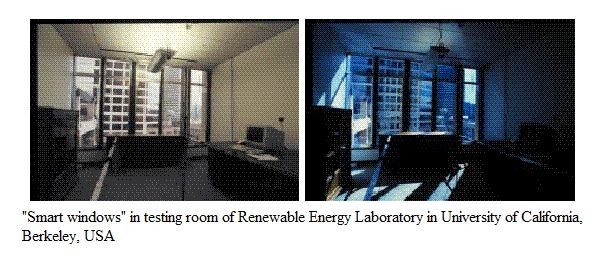
A Satellite Workshop titled: “Transition Metal Oxide Thin Films-functional Layers in “Smart windows” and Water Splitting devices: Technology and Optoelectronic properties”, will be organized and will take place together with the 18th International School on Condensed Matter Physics, the dates for the Meeting are envisaged to be 4th-6th of September 2014.
Chromogenic “Smart windows” are the windows in the future low-energy architectural buildings and car industry. The specific electronic structure of transition metals and their oxides permits to these materials to express electrochromic, thermochromic or gazochromic effects. The electrochromic effect is a change in the optical transmittance of a film as a result of application of low voltage. In order to visualize the effect, the film must be part of a multilayer structure, called Smart window. The “Smart window” system consists of two conductive glasses over one of which the electrochromic film is deposited. The glasses are stacked together by ion containing polymeric electrolyte. If a low voltage is applied to the electrodes (to both conductive glasses), electron injection and ion intercalation in the film structure starts. In result, an absorptive temporary film is formed. It absorbs part of the solar light and exhibits a complementary colour. The visualized colour depends on the type of the oxide used. It could be bluish, brownish, yellowish, etc. For example the tungsten oxide absorbs in near infrared and exhibits blue colour. The process is reversible i.e. if the polarity of the voltage is changed, the system returns in its initial state and the device becomes transparent again. In this way, dynamic control over the energy of solar flux can be established.
Some oxides are able to exhibit thermochromic effect, i.e. to change their optical properties with temperature. Vanadium dioxide is known to show a reversible semiconductor-to-metal transition at 68oC whereat a crystallographic change from monoclinic to tetragonal structure is performed. Along with this transition, a substantial change in the electrical resistivity and optical behaviour is observed. Such materials, being simple and less expensive compared to these used in electrochromic devices, offer possibility for applications in optical switching elements and energy control devices such as “Smart windows”.
Another important application of transition metal oxides is the production of electrochemical “Water Splitting’ photocells, in which the functional electrode is a thin film of transition metal oxide. Such novel technologies, using the power of sunlight to efficiently split water into its components of hydrogen and oxygen are of great importance for the broad use of hydrogen as a green fuel.
Chemical and physical vapour deposition (CVD and PVD) processes are the main technologies utilized for deposition of transition metal oxides. Comparatively new and very prospective technology i.e. Atomic Layer Deposition (ALD) for production of nanostructured multifunctional thin film materials will be in the focus of the seminar presentations. Bulgarian and European specialists in the field of nanomaterial science are invited to give lectures on classical and modern technologies for thin film deposition and characterization, including Ellipsometry, Raman, Infrared modulation spectra measurements, Spectrophotometry, different structural investigation methods, etc.





 Saving...
Saving...